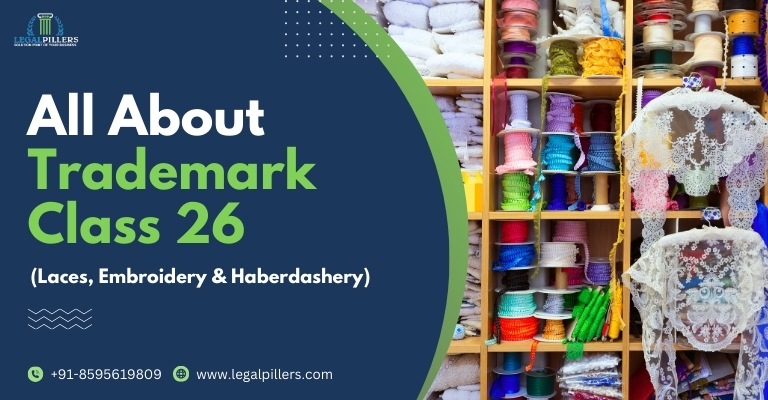
Table of Contents
All About Trademark Class 26
Trademark Class 26 is a classification under the Nice Classification System, which is an international classification of goods and services used for trademark registration. Class 26 specifically includes products related to dressmaking and decorative arts, such as lace, ribbons, buttons, needles, and other sewing and embroidery accessories, as well as artificial flowers and hair ornaments. When a trademark is registered under Class 26, it means that the owner has exclusive rights to use that trademark in connection with these types of goods. This classification helps in organizing and categorizing trademarks for legal and registration purposes.
Important goods included in Trademark Class 26
Trademark class 26 mainly includes dressmakers’ articles, natural or synthetic hair for wear, and hair adornments, as well as small decorative items intended to adorn a variety of objects, not included in other classes. The goods that have been included in this trademark class are as given below:
- Wigs, toupees, false beards
- Barrettes, hair bands
- Ribbons and bows being haberdashery or used as hair decorations, made of any material
- Ribbons and bows for gift wrapping, not of paper
- Hair nets
- Buckles, zippers
- Charms, other than for jewellery, key rings, or key chains
- Artificial Christmas garlands and wreaths, including those incorporating lights
- Certain articles for curling hair, for instance, electric and non-electric curlers, other than hand implements, hair curling pins, hair curling paper
Goods does not included in Trademark Class 26
- False eyelashes (included in class 3)
- Hooks being small items of metal hardware (included in class 6)
- Hooks being small items of hardware, not of metal (included in class 20)
- Curtain hooks (included in class 20)
- Certain special types of needles, for example,-
- Tattoo needles (included in class 8)
- Needles for surveying compasses (included in class 9)
- Needles for medical purposes (included in class 10)
- Needles for pumps for inflating balls for games (included in class 28)
- Hand implements for curling hair, for instance, curling tongs, and eyelash curlers (included in class 8)
- Hair prostheses (included in class 10)
- Jewellery charms, charms for key rings or key chains (included in class 14)
- Certain ribbons and bows, for example, paper ribbons and bows, other than haberdashery or hair decorations (included in class 16), rhythmic gymnastics ribbons (included in class 28)
- Yarns & threads for textile use (included in class 23)
- Christmas trees of synthetic materials (included in class 28)
List of examples of Trademark Class 26
- Metro: Knitting pins and needles, etc.
- Swastik: Lace and embroidery, ribbons and braid, buttons, hooks, etc.
- Nish Hair: Wigs, hair extensions, etc.
- Cow: Needles, press buttons, safety pins, pins, hooks, scissors, tailoring, etc.
- Aromi: Safety pins, alpins, pins, etc.
- Bell: Needles, buttons, pins, hooks, zip fasteners, sliders, etc.
- Anchor: Pins, needles, buttons, clothes hangers, clothes packing materials, etc.
- Parker: Buttons, hooks, eyes, pins & needles, etc.
- Alchemane: Wigs, hairpieces, and add-in and add-on hair accessories, etc.
List of goods classified under Trademark Class 26
A
- Appliqués [haberdashery]
- Artificial Christmas garlands
- Artificial Christmas garlands incorporating lights
- Artificial Christmas wreaths
- Artificial Christmas wreaths incorporating lights
- Artificial flowers
- Artificial fruit
- Artificial garlands
- Artificial plants, other than Christmas tree
B
- Badges for wear, not of precious metal.
- Beads, other than for making jewellery.
- Belt clasps
- Binding needles
- Birds’ feathers [clothing accessories]
- Blouse fasteners or dress body fasteners
- Bobbins for retaining embroidery floss or wool [not parts of machines]
- Bodkins
- Bows for the hair
- Boxes for needles
- Bra extenders
- Bra strap extenders
- Braids
- Brassards and armbands [clothing accessories]
- Breast lift tapes
- Brooches [clothing accessories]
- Buckles [clothing accessories]
- Buckles for bags
- Buttons*
C
- Charms, other than for jewellery, key rings or key chains
- Chenille [passementerie]
- Clasps for bags
- Clasps for coin purses
- Collar supports
- Competitors’ numbers
- Cords for clothing
- Cords for trimming
- Corset busks or whalebones for corsets
- Crochet hooks/ needles
D
- Darning needles
- Darning lasts
- Decorative articles for hair
- Decorative charms for cellular phones
E
- Edging for clothing
- Elastic ribbons
- Embroidering needles
- Embroidery/ fancy goods [embroidery]
- Expanding bands for holding sleeves
- Eyelets for clothing
F
- False beards
- False hair
- False hems
- False moustaches
- Fastenings for clothing
- Fastenings for suspenders and fastenings for braces
- Feathers [clothing accessories]
- Festoons [embroidery]
- Fittings for lingerie [haberdashery]
- Frills [lacework]
- Frills for clothing
- Fringes
G
- Gold embroidery
H
- Haberdashery [dressmakers’ articles]*, except thread
- Haberdashery bows
- Haberdashery ribbons
- Hair bands
- Hair grips or bobby pins
- Hair curling pins
- Hair barrettes or hair slides
- Hairpins
- Hair nets
- Hair colouring caps
- Hair curling papers
- Hair extensions
- Hair curlers, electric and non-electric, other than hand implements
- Hat pins, other than jewellery
- Hat trimmings
- Hatbands
- Heat adhesive patches for repairing textile articles
- Heat adhesive patches for decoration of textile articles [haberdashery]
- Hook and pile fastening tapes
- Hooks [haberdashery]
- Hooks for corsets
- Human Hair
K
- Knitting kits
- Knitting needles
L
- Lace for edgings
- Lace trimmings and passementerie
- Lanyard cords for clothing
- Letters for marking linen
- Lingerie tapes
M
- Mica spangles
N
- Needle cushions
- Needle cases
- Needles*
- Needle threaders
- Numerals for marking linen
O
- Ornamental novelty badges [buttons]
- Ostrich feathers [clothing accessories]
P
- Picot [lace]
- Pin cushions
- Pins, other than jewellery
- Plaited hair or tresses of hair
- Prize ribbons
R
- Ribbons and bows, not of paper, for gift wrapping
- Ribbons for the hair
- Rosettes [haberdashery]
- Rug hooks
S
- Saddlers’ needles
- Sewing kits
- Sewing needles
- Sewing boxes
- Sewing thimbles
- Shoe fasteners
- Shoe hooks
- Shoelaces
- Shoe trimmings
- Shoe eyelets
- Shoe buckles
- Shoemakers’ needles
- Shoulder pads for clothing
- Shuttles for making fishing nets
- Silver embroidery
- Skirt flounces
- Snap fasteners
- Spangles for clothing
T
- Tapes for curtain headings
- Tassels [haberdashery]
- Top-knots [pompoms]
- Toupees
- Trimmings for clothing
- Trouser clips for cyclists
U
- Underwires for brassieres
W
- Wigs
- Woollen laces
- Wreaths of artificial flowers
Z
- Zip fasteners/ slide fasteners/ zippers
- Zippers/ zip fasteners for bags
Conclusion
Trademark Class 26 encompasses a wide range of products related to dressmaking, decorative arts, and crafting. It includes items such as lace, ribbons, buttons, needles, and various sewing and embroidery accessories, as well as artificial flowers and hair ornaments. Registering a trademark under Class 26 provides exclusive rights to use that trademark in connection with these goods, helping businesses protect their brand identity within this specific category. Whether you are a fashion designer, a haberdashery supplier, or a craft enthusiast, understanding and properly classifying your trademarks in Class 26 is essential for legal protection and brand recognition in this niche market.
At LegalPillers, we are here to help you in reducing the complications of trademark registration and classification effectively, ensuring that your brand is adequately safeguarded within this important class. Choose LegalPillers as your trusted partner for classifying and registering the trademark under this class.
(FAQ) about Trademark Class 26
What is Trademark Class 26?
● Trademark Class 26 is one of the categories within the Nice Classification system used for trademark registration. It covers a variety of goods related to dressmaking, sewing, and decorative arts.
What types of products are included in Class 26?
● Class 26 includes products such as lace, ribbons, buttons, needles, pins, embroidery and sewing thread, artificial flowers, and hair ornaments. It encompasses items commonly used in fashion, crafting, and textile work.
Why is it important to classify trademarks under Class 26?
● Properly classifying trademarks ensures that they are protected within the specific category of goods or services they represent. For businesses dealing with haberdashery or decorative items, Class 26 is crucial to safeguard their brand identity.
Can I register my fashion brand name in Class 26?
● Yes, if your fashion brand produces or sells products like ribbons, lace, or buttons, you should consider registering your trademark in Class 26 to protect your brand within this specific category.
Do I need to register my trademark in multiple classes?
● It depends on the nature of your business and the goods or services you provide. If your business is involved in multiple activities or offers a variety of products, you may need to register your trademark in multiple classes to ensure comprehensive protection.
How do I apply for a trademark in Class 26?
● To apply for a trademark in Class 26, you need to submit an application to the relevant trademark office in your jurisdiction. The application process typically involves providing detailed information about your trademark and paying the required fees.
Can someone else use my registered trademark in Class 26 for similar products?
● No, once your trademark is registered in Class 26, you have exclusive rights to use it for the specified goods. Others cannot use a similar trademark for similar products without your permission.
How long does trademark registration in Class 26 last?
● The duration of trademark registration varies by country but typically lasts for a period of 10 years. You can renew it indefinitely as long as you continue to use the trademark.
What happens if someone infringes on my trademark in Class 26?
● If someone uses your trademark without permission in connection with similar goods covered by Class 26, you may take legal action against them, including sending cease-and-desist letters, filing a lawsuit, or seeking damages for infringement.
Can I change the class of my trademark registration?
● Changing the class of your trademark registration is possible in some cases but can be complex. It is advisable to consult with a trademark attorney for guidance on such matters.



Leave a Reply